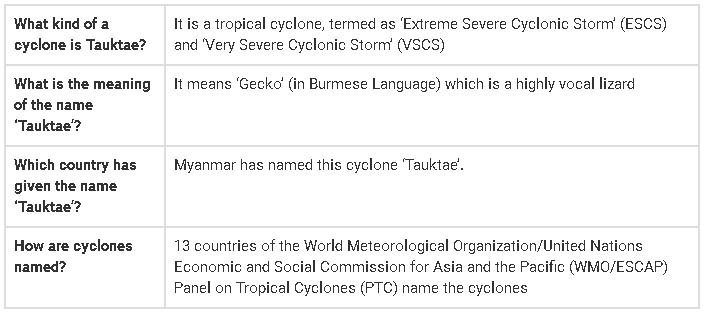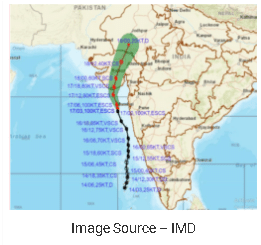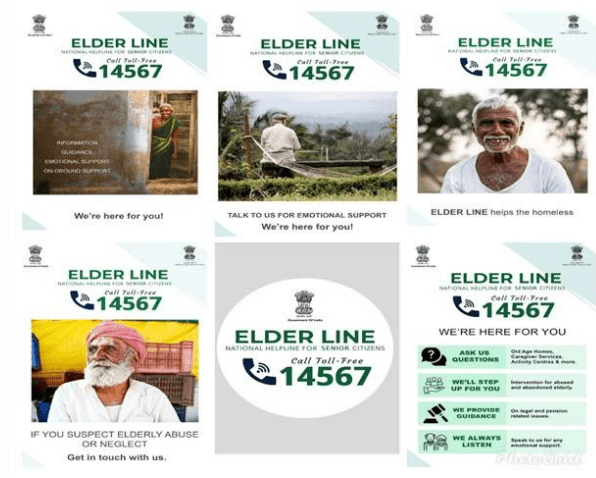PIB Summary- 17th May, 2021 | PIB (Press Information Bureau) Summary - UPSC PDF Download
Cyclone Tauktae
Context: The landfall process of the eye of ‘extremely severe cyclonic storm’ Tauktae, which had hit the Gujarat coast in Saurashtra between Diu and Una around 9 pm, ended around 12 am on 17th May, according to the IMD.
Details
- The cyclone had weakened from an ‘extremely severe cyclonic storm’ into a ‘very severe cyclonic storm’.
A low-pressure area over the Arabian Sea first concentrated into a depression and later intensified into a cyclonic storm named ‘Cyclone Tauktae’. The West Coast of India has been affected by the cyclone. It is the first cyclone of 2021.
Some brief facts about Tauktae Cyclone for the IAS Exam are given below:

In 2020, the following cyclones hit the Indian regions:
- Cyclone Nisarga
- Cyclone Amphan
Arabian Sea and Cyclone Tauktae
Due to global warming Arabian Sea has been warming up in recent years and Cyclone Taukate is the fourth cyclone in consecutive years to have originated from the sea. Typically, out of the average of five cyclones that develop annually in the Bay of Bengal and Arabian Sea region, four are formed over the Bay of Bengal (It being warmer than the Arabian Sea).
The warmer temperature supports active convection, heavy rainfall, and intense cyclone activity.
However, Arabian Sea water too is warming up which provides an ample amount of energy that enables the intensification of tropical cyclones. Cyclone Tauktae is the result of the same process where the warm waters of the Arabian Sea (up to the depths of 50 metres) led to a low-pressure system that underwent multiple stages of intensification to form a cyclone.
Facts about Cyclone Tauktae
- It has originated over the Arabian Sea.
- After Cyclone Vayu of 2019 and Cyclone Nisarga of 2020, Taukate Cyclone has come very close to the west coast of India for the third consecutive year.
- Cyclone Tauktae has made 2021 the fourth consecutive year to witness the development of a cyclone over the Arabian Sea in a pre-monsoon period.
- The Indian coastal regions of the following states are affected by Cyclone Tauktae:
- Gujarat
- Maharashtra
- Goa
- Kerala
- Karnataka, and
- Tamil Nadu
Cyclone Tauktae – State Preparedness
IMD
Indian Meteorological Department (IMD) is the Indian agency to monitor the development of tropical cyclones in its area of responsibility and provides advisory information to ICAO, DGCA, Meteorological Watch offices in the country and neighbouring countries as well.
In the wake of Cyclone Tauktae, IMD has released relevant information and put places on alerts to avoid any severe impact caused by it.
As of 17th May 2021, the IMD released the following information:
- The Cyclone Tauktae that originated over the East Central Arabian Sea has moved north and northwestwards with a speed of 15kmph.
- Coastal Mumbai, South-South East of Diu, South-South East of Veraval (Gujarat) are to be impacted.
- It is expected to reach Gujarat Coast and cross it between Porbandar and Mahuva with a speed of 155-165 kmph by the evening of Monday (17th May.)
As per the IMD, the track and intensity of the Cyclone Tauktae are given below:


INSAT-3D
ISRO’s meteorological satellite is being used which is designed for enhanced meteorological observations and monitoring of land and ocean surfaces for weather forecasting and disaster warning. The imagery released by INSAT 3D is helping track the cyclone.
Conclusion
A few terms/topics in relation to cyclones that a UPSC 2021 candidate should know about:
- Cyclogenesis – The development and strengthening of cyclones in the atmosphere.
- Low-pressure area – The region where the atmospheric pressure at sea level is below that of surrounding locations. Areas of wind divergence that occur in upper levels of the troposphere are associated with low-pressure systems.
- High-pressure area – Light winds at the surface and subsidence at the lower portion of the troposphere are commonly associated with high-pressure areas.
- Cyclone Disaster Management
- Extra-Tropical Cyclones
MyGov Innovation Challenge
Context: MyGov launches innovation challenge for creating Indian Language Learning App.
Details
- MyGov has launched an Innovation Challenge for creating an Indian Language Learning App.
- MyGov has launched the challenge in partnership with the Department of Higher Education, Ministry of Education, GOI.
- The challenge is to create an app that will enable individuals to learn simple sentences of any Indian language and acquire working knowledge of a language.
- Challenge objective: to create an app that will promote regional language literacy, thereby creating greater cultural understanding within the country.
- The key parameters for judging are: Graphical User Interface, UI/UX, ease of use, gamification features, simplicity, superior content, scalability, interoperability, etc.
- The challenge is open to Indian individuals, start-ups and companies.
- MyGov envisions the app to be multi-modular, with the capacity to teach through the written word, voice and video/visuals.
- Upon evaluation of submission of prototypes, the top 10 teams will be invited to make presentations and top 3 will be selected by a jury. The top 3 will receive funding of INR 20, 10 and 5 lakhs to make the apps better.
Elderline
Context: Toll Free Helpline for elderly persons ELDERLINE (14567) becomes operational in several states.
Details
- The Ministry of Social Justice has started state-wise call centres in five major states to address the problems faced by elderly people in the wake of the covid pandemic.
- The toll free helpline for elderly persons called ELDERLINE is expected to become operational in all states by the end of May 2021.
- The states covered are Karnataka, Madhya Pradesh, Uttar Pradesh, Tamil Nadu and Rajasthan. It was already working in Telangana since one year.
- The toll free number by which the call centres can be reached is 14567.
- Tata Trusts and NSE Foundation have assisted in operationalising this facility.

Samvedna
Context: Children impacted by Covid-19 Pandemic being provided Tele Counselling through SAMVEDNA.
What is SAMVEDNA?
- SAMVEDNA tele counselling service is for psychological support to children to address their stress, anxiety, fear and other issues during the coronavirus pandemic.
- The service is provided by the National Commission for Protection of Child Rights (NCPCR).
- Counselling through telephone is provided to children in three categories:
- Those who are in quarantine/isolation/covid care centres.
- Those whose parents or near ones have been tested positive for COVID.
- Those who have lost their parents to COVID.
- The service was launched in September 2020 and is available in various regional languages.
- The counsellors have been trained under an eminent professor of the Department of Child and Adolescent Psychiatry and his team from NIMHANS.
- SAMVEDNA is an acronym for ‘Sensitizing Action on Mental Health Vulnerability through Emotional Development and Necessary Acceptance’.
- The toll free number 1800-121-2830 is available from Monday to Saturday from 10 a.m. to 1 p.m. and 3 p.m. to 8 p.m.
 |
Download the notes
PIB Summary- 17th May, 2021
|
Download as PDF |
Ministry of Tribal Affairs and Microsoft signed MoU
Context: The MoU was signed between the Ministry and Microsoft for the digital transformation of tribal schools, especially Eklavya Model Residential Schools (EMRS) and Ashram Schools, etc.
Details
- Under affirmative action initiative, Microsoft will make AI curriculum available to tribal students in both English and Hindi at all EMRS schools under the Ministry to skill educators and students in next-generation technologies including Artificial Intelligence.
- The program is aiming at bridging the gap between tribal students and other students in this field.
- Teachers across states in India will be trained in a phased manner for using productivity technologies like Office 365 and AI applications in teaching, helping them deliver blended or remote learning experiences to students in a more personalized, productive and secure manner.
- Students will be mentored on projects that involve AI applications for societal good and the UN’s Sustainable Development Goals (SDGs).
- Students will also be trained and exposed to gamified environments on Minecraft to help build design thinking skills.
- Microsoft will work with schools under the Ministry to accelerate digital transformation.
- The schools will be provided with the technology, training and tools needed to transform them into Microsoft Showcase Schools.
Scientists developed magnetometer for low cost, reliable & real-time measurements of magnetic fields
What’s in News?
- Scientists from the Raman Research Institute (RRI), Bengaluru, have devised a more efficient, faster, and low-cost digital receiver system that can make precise measurements of magnetic fields.
- RRI is an autonomous institute under the GOI’s Department of Science and Technology.
- The new study is supported by the DST and the Ministry of Electronics and IT.
Background
- Digital signals are the backbone of communication systems processed by hardware systems that transmit and receive the signals with the help of intermediate systems called ‘digital receiver systems’ or DRS.
- When magnetic matter creates signals, analysing them with DRS lets scientists study the magnetic fields.
- By analysing the properties of the signals, for example, how they vary with time, scientists can measure the fields and study their small fluctuations.
Significance
- The researchers have demonstrated a low-cost digital system to efficiently measure unknown magnetic fields.
- They developed a digital receiver system using heated rubidium atoms.
- Having demonstrated the functioning of a digital receiver system to precisely measure atomic magnetic fields, the researchers are open to large-scale manufacturing or commercialisation of the device.
























